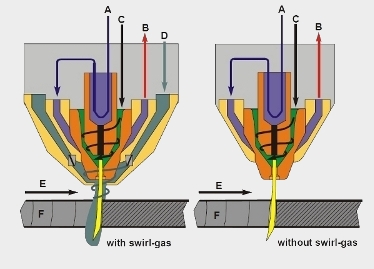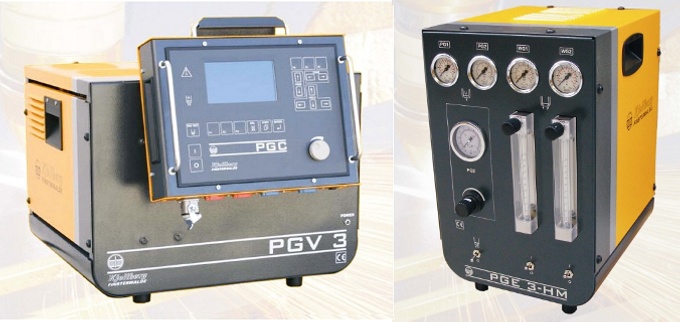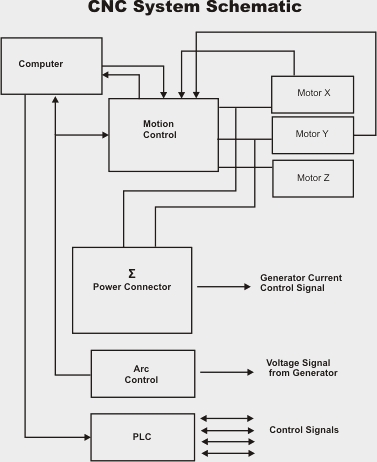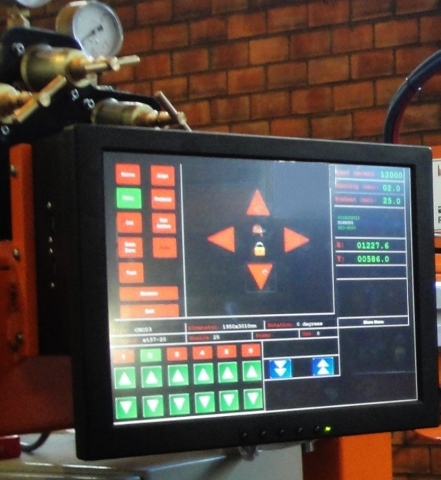Manufacturers of Plasma Cutting machines, developing and refining the technologies related to it, have presented, in the last decade, high definition Plasma Cutting Machines. High Definition Plasma cutting offers important advantages compared to the conventional technology. The advantages in question are:
-
1. Great improvement as far as cut “verticality” is concerned, with more “square” cuts.
-
2. Cutting with next to zero dross is possible.
-
3. Thinner kerfs
-
4. The same machine can cut a wide range of sheet thicknesses, from very thin (0.5 mm) to very thick (e.g. 60 mm)
On the other hand, it must be understood that High Definition cutting embodies changes into the whole cutting process and all subsystems are affected: Plasma torch, power supply, gas distribution system, cutting table and motion transmission systems as well as the CNC drives controlling the whole procedure. In case all the pre-mentioned subsystems do not cooperate to balance, the advantages of High Definition Plasma cutting could be annihilated. In the following, we will try to describe in detail the relevant subsystems, avoiding high tech terminology as much as possible in an effort to help prospective buyers judge which machine best suits their needs by themselves. Let us make one thing clear once and for all: mounting a high definition plasma torch on just any pantograph will NOT give us the best cutting results possible!
High Definition Plasma Cutting Torch
 |
|
|
Plasma torch design with and without Swirl Gas
A. Coolant entry, B. Coolant exit,
C. Plasma Gas, D. Swirl Gas,
E. Cutting direction and F. Cut surface.
|
The cutting torch is perhaps the subsystem of the most critical importance. Differences in torch design differentiate one manufacturer to any other. High Definition Plasma Torches are always of double gas cutting technology. As seen in the first picture (please enlarge to cheque the details), there are two gases: the cutting gas, in a plasma state, which cuts the metal, and a second gas, electrically neutral, which encircles the cutting gas jet. This second gas is called shielding gas and has three main purposes:
-
a. to shield the nozzle against molten metal spattered on it while cutting or piercing, resulting in substantial prolongation of nozzle life,
-
b. to insulate the cutting area against air and the eventual deterioration (burning or blackening) of the cut surface (unacceptable in some cases e.g. inox) due to the oxygen contained in it,
-
c. to stabilize and better focus the cutting gas jet; the shielding gas is forced into a swirling movement while travelling through the torch (as it sometimes is the case with the cutting gas as well). As a result, the cutting gas jet is “protected” in the revolving cylinder formed by the shielding gas. A high definition torch is also better designed as far as its aerodymamic characteristics are concerned; the design as a whole results in a substantial improvement to the focusing and stability properties of the cutting jet blown out of the nozzle.
Power Generator
The Power Generator supporting a High Definition torch must have some special characteristics:
-
1. Wide range of current adjustment (e.g. 10-100 A). This is because the high Definition torches can cut from 0.3mm up to 100mm and the power generator should be adjusted accordingly. This is achieved only by using “chopper” or “inverter” technology.
-
2. On the Fly power adjustment. This is because in modern High Definition systems CNC can control pulsating power and adjust it to the cutting velocity. In other words, the Power Generator must be able to adjust to the CNC orders.
-
3. A reliable and flexible interconnection system between CNC and Arc Control (Torch Height Control)
Plasma Gas Control
 |
Automatic and Manual Gas Flow Controls
(Source: Kjellberg Finsterwalde) |
The Plasma Gas Control Unit is critical to High Definition Plasma cutting. This is easily understandable by taking into consideration that different gas mixtures are used for ignition, for cutting and for shielding of the cutting jet. Optimal control of all these gas mixtures is of huge importance for optimal cutting quality. There are two types of gas distributors or gas mixers: the manual ones and the computer controlled ones, or else automatic distributors. On manual distributors, the user adjusts gas mixtures and flow speeds manually, after special charts. On automatic mixers only the material to cut and its thickness are set manually, and everything else is left to automation. Most importantly, auto mixers adjust gas flow during the whole cutting process (against manually adjusting it once before its start), and it can proceed to all necessary real-time corrections so that gas flow remains constantly at optimal levels. This way, auto mixers have contributed to impressively better cut quality. Unfortunately not without a substantially greater cost; the decision whether it is worth investing in it or not is up to the customer.
 |
|
Diagram of a modern CNC system |
Cutting Table - Gantry movement
The Cutting table and Gantry mechanics are of utmost importance: Movement precision and repeatability are decisive factors. The whole system should be designed to achieve accelerations from 3 m/sec2 up to 6 m/sec2, a prerequisite for high definition cutting. Equally important factors are movement precision and sturdiness of the construction along the z axis, indispensable for the correct functioning of cutting height automation (Arc Control or THC-Torch Height Control).
CNC – Electronics
This is perhaps the most important subsystem of a High Definition system; when automation is outdated, all advantages offered by the new High Definition technology are out of reach. Unfortunately, although there are hundreds of gantry machine manufacturers worldwide, machines meeting the latest automation development standards and characteristics are desperately few. This is only logical, since most manufacturers worldwide do not have the Know-How and/or the technology to produce them, and are only buying ready-made electronics and CNC systems designed for mass production purposes. Fine-adjustment of these automations is out of the question, the prerequisite Know-How would make outsourcing meaningless in the first place!
CNC for High Definition Plasma
 |
CNC Control Unit:
Europath V2.0 by IDA Control |
In the following, we will describe how a modern CNC for High Definition plasma should be: The CNCs in question should come near to the Laser CNC standards. They should have Response Time less than 0.5 msec (servo loop) and, definitely, real time control over the generator source. This technology permits us to have a linear control of the cutting power, combined with the cutting velocity. Whenever the cutting torch has to slow down, the power must decrease, keeping, though, the least Plasma density to the level required for the continuation of the cutting job, and vice versa. It must also be able to support pulse mode for piercing, very useful to achieve easy piercing of very thick sheets. Torch Height control (THC) should be undertaken by a fully digital Arc Control System, with automatic tracking of holes and interconnected to the CNC to maintain constant height regardless the fluctuations in velocity.
If the pre-mentioned systems are not there, the pantograph is simply a machine for improved cutting without taking advantage of all recent technological capabilities offered to the manufacturer. This is the main reason why the best of such developed systems are only found with vertical manufacturers who, on top of the Cutting Technology Know-How, they also possess the Know-How of both Electronics and Software development. The prospective buyer of a High Definition Plasma Cutting machine should also seriously consider the Plasma Generator type and its manufacturer, but, above all, the Know-how and the trustworthiness of the manufacturer and distributor of the whole system. Machinery of this kind does not come cheap! Collect information beforehand not only from manufacturers but from machine buyers and users as well!
Taking into consideration that such systems need serious technical support through the initial phases of their installation and integration into the customer’s line of production, the best choice of the proper supplier and the proper technology is the key to a successful purchase.
(Based on an article by Panagiotis Pikis published in the Greek bimonthly "Metal Sheet Cutting and Forming", December 2009)





